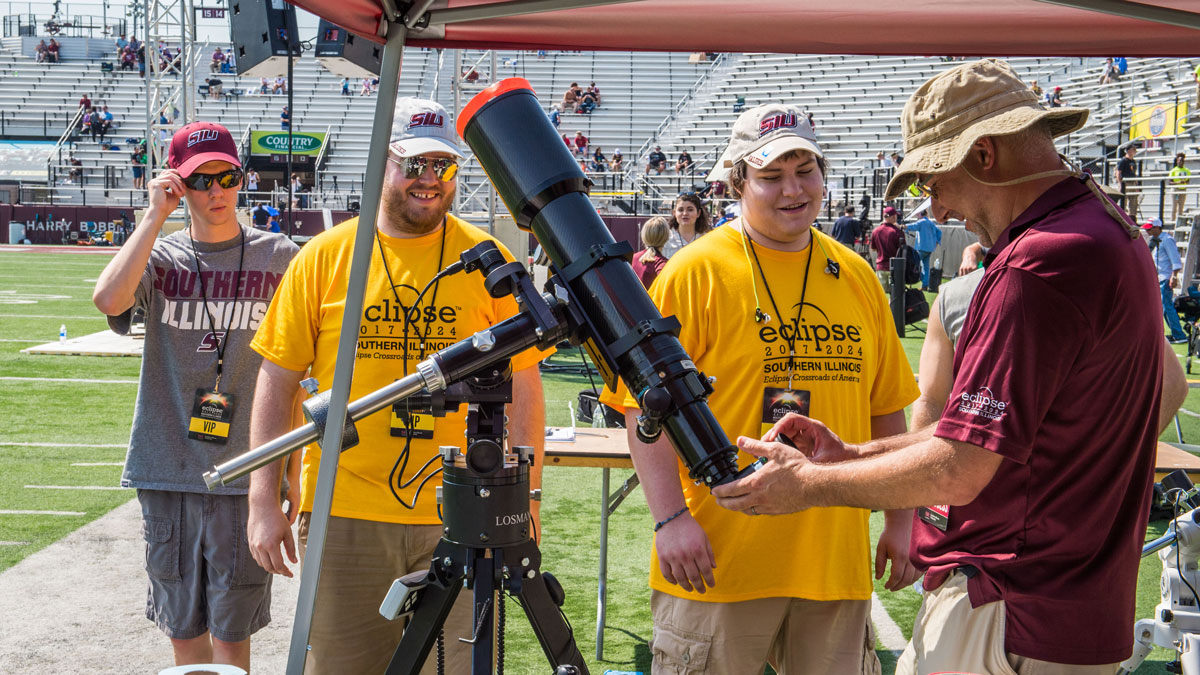
October 02, 2023
SIU plans activities for annular solar eclipse on Oct. 14
CARBONDALE, Ill. – A naturally occurring warm-up for the total solar eclipse in April will happen in October, and Southern Illinois University Carbondale is planning activities that will help the public enjoy and learn from it.
An annular solar eclipse is set for Oct. 14 along a path from Oregon to Texas. An annular eclipse involves the moon passing between the sun and Earth while the moon is at or near its farthest point from Earth. To a viewer on Earth, this prevents the moon from completely covering the sun, such as occurs during a total solar eclipse. Southern Illinois, however, will be able to witness a partial solar eclipse during the event.
SIU is planning programming aimed at adding to the enjoyment of the celestial event. The university will provide solar telescopes, family-friendly hands-on astronomy and science activities, as well as informational tabling from 10 a.m. to 2 p.m. at Saluki Stadium that day.
Visitors also are welcome to bring their own lawn chairs and blankets as well as photography or telescope equipment, or to watch from the Saluki Stadum seating. Viewers should not look at the sun with the naked eye.
The annular eclipse begins at 10:33 a.m. and ends at 1:30 p.m., with maximum eclipse at 11:59 a.m. SIU will make eclipse viewing glasses available at no charge, and no registration or tickets are required to attend the event. Limited concessions for purchase will be available on site.
Organizers also will provide live television feeds of the annular eclipse from across the country on the stadium’s big screen, while NASA EDGE television will be filming inside Saluki Stadium. The SIU vs. Murray State football watch party on the big screen will follow the eclipse broadcast.
Bob Baer, specialist in the School of Physics and Applied Physics and co-chair of SIU’s Eclipse Committee, said the annular eclipse will provide a glimpse into what the area has to look forward to in April during the total solar eclipse.
“It is similar to what you see an hour or so leading up to a total solar eclipse, but that is where the similarity between annular and total ends,” Baer said.
In Southern Illinois, the sun will be obscured a maximum of 64%, with the orb appearing as a crescent when viewed though solar glasses or solar telescopes. In the direct path of the annular eclipse, viewers will see 90% coverage of the sun, which means it will not get dark the way it does during a total solar eclipse, nor will the corona be visible, Baer said.
“People without access to solar glasses or a solar telescope may not notice there is an eclipse going on, which is one reason our event is special,” Baer said. “It’s a great chance for people who have never seen an eclipse or may not have ever looked at the sun. They can do so safely with the guidance of our outreach professionals. Some of the best solar scopes available will be in the stadium, as well as through remote feeds. This is something space science enthusiasts will not want to miss.”
The day before the eclipse, on Oct. 13, the university also will play host to Blair Allen, NASA EDGE producer and co-host, who will give a talk as part of SIU’s Eclipse Talk Series. Allen’s travels for NASA EDGE have taken him around the globe. He will speak at 3 p.m. in the Guyon Auditorium at Morris Library, with the talk also streamed live on Zoom.
Volunteers and tablers needed
To volunteer for the event, sign up online. To participate in the event by running an information table, visit fill out the form. Organizers welcome tabling or hands-on activities, especially related to space-science or any activities that showcase SIU.
